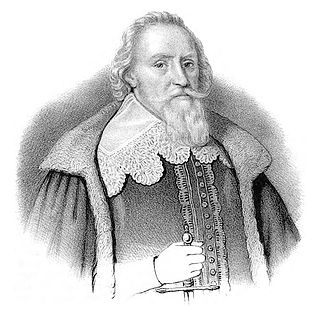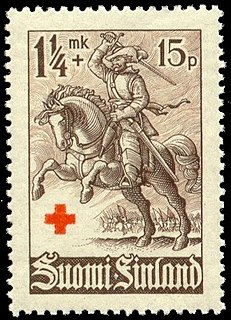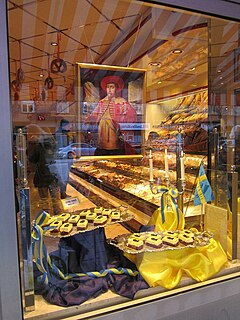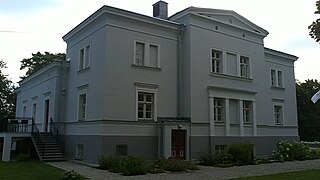
Axel Gustafsson Oxenstierna af Södermöre, Count of Södermöre, was a Swedish statesman. He became a member of the Swedish Privy Council in 1609 and served as Lord High Chancellor of Sweden from 1612 until his death. He was a confidant of King Gustavus Adolphus and then Queen Christina, of whom he was at first regent.

Johan Skytte was a Swedish statesman who founded the University of Tartu.

Hakkapeliitta is a historiographical term used for a Finnish light cavalryman in the service of King Gustavus Adolphus of Sweden during the Thirty Years' War. Hakkapeliitta is a 19th-century Finnish modification of a contemporary name given by foreigners in the Holy Roman Empire and variously spelled as Hackapelit, Hackapelite, Hackapell, Haccapelit, or Haccapelite. These terms were based on a Finnish battle cry hakkaa päälle, commonly translated as "Cut them down!"

The Royal Gustavus Adolphus Academy in Uppsala is one of 18 Swedish royal academies and dedicated to the study of Swedish folklore. The name is often expanded to Kungl. Gustav Adolfs Akademien för svensk folkkultur.

Tre Kronor was a castle located in Stockholm, Sweden, on the site where Stockholm Palace is today. It is believed to have been a citadel that Birger Jarl built into a royal castle in the middle of the 13th century. The name "Tre Kronor" is believed to have been given to the castle during the reign of King Magnus IV in the middle of the 14th century.

Katedralskolan is a school in Uppsala, Sweden. The school was, according to tradition, established in 1246. It is the oldest educational institution in Uppsala, and one of the oldest in Sweden.
Gustav Adolf or Gustaf Adolf may refer to:
The history of formal education in Estonia dates back to the 13–14th centuries when the first monastic and cathedral schools were founded. The first primer in the Estonian language was published in 1575. The oldest university is the University of Tartu which was established by the Swedish king Gustav II Adolf in 1632. In 1919, university courses were first taught in the Estonian language.

Gustavus Adolphus Day is celebrated in Sweden, Finland, and Estonia on 6 November in memory of King Gustavus Adolphus of Sweden. Observing the day became popular after the 200th anniversary of the king's death in 1632. It is a general flag flying day in Sweden and Finland. Today it is mainly connected with the consumption of Gustavus Adolphus pastries.
Gustav Adolf of Sweden - English also: Gustavus Adolphus ; Swedish: Gustav Adolf and : Gustaf Adolf - may refer to:
Tõnis Kimmel is an Estonian architect.

Vihterpalu is a village in Lääne-Harju Parish, Harju County in northern Estonia.

Saka is a village in Toila Parish, Ida-Viru County in northeastern Estonia.

Tallinn French School or Tallinn French Lyceum, is a co-educational comprehensive secondary school in Tallinn, Estonia. It offers primary and secondary education. Students perform consistently well in national exams, often placing the school in the national top 5.

Gustavus Adolphus, also known in English as Gustav II Adolf or Gustav II Adolph, was King of Sweden from 1611 to 1632, and is credited for the rise of Sweden as a great European power. During his reign, Sweden became one of the primary military forces in Europe during the Thirty Years' War, helping to determine the political and religious balance of power in Europe. He was formally and posthumously given the name Gustavus Adolphus the Great by the Riksdag of the Estates in 1634.

Gustavus Adolphus pastry is a pastry traditionally eaten every 6 November in Sweden, Gustavus Adolphus Day, the death day of King Gustavus Adolphus the Great. It is especially popular in Gothenburg, a city founded by the king.

Estonia under Swedish rule signifies the time between 1561 and 1710, when parts of present-day Estonia were under Swedish rule. In the wake of the breakup of the State of the Teutonic Order, the Baltic German local aristocracy in the areas of Harrien (Harjumaa) and Wierland (Virumaa), as well as the city of Reval (Tallinn) in June 1561 asked for and were granted protection by the Swedish king Eric XIV, leading to Swedish involvement in the Livonian War. At the conclusion of hostilities in 1583, Sweden was in control of the northern parts of modern Estonia and Dagö ; the Duchy of Estonia was created from this territory. Following renewed wars between Poland and Sweden, the southern parts of present-day Estonia were incorporated into Sweden by the Treaty of Altmark in 1629. Sweden also conquered the island of Ösel (Saaremaa) from Denmark, and were thus in control of all of present-day Estonia.

Events from the year 1631 in Sweden

Wahl family originated in Scotland and then settled in the Baltic states.

Tallinn Secondary School of Science is a gymnasium in Tallinn, Estonia.
















